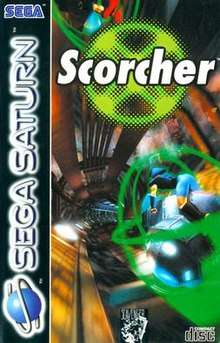Scorcher (video game)
| Scorcher | |
|---|---|
 European Saturn cover art | |
| Developer(s) | Zyrinx |
| Publisher(s) |
MS-DOS and Windows Scavenger Sega Saturn
|
| Composer(s) | Jesper Kyd |
| Platform(s) | MS-DOS, Windows, Saturn |
| Release |
Windows
|
| Genre(s) | Racing |
| Mode(s) | Single player |
Scorcher is a futuristic racing video game by Danish developer Zyrinx,[2] released in 1996 for the PC and the Sega Saturn. Originally announced under the name "Vertigo",[3] the game focuses on special motorcycles that reach up to 450 km/h racing through dangerous tracks in a dystopian year 2021.
Scorcher was one of the most graphically advanced Sega Saturn games of its time, enough so that Sega shipped an unfinished version of the game to third party developers as a graphics demo for the Saturn.[4]
Reception
| Reception | ||||||||||||||
|---|---|---|---|---|---|---|---|---|---|---|---|---|---|---|
| ||||||||||||||
Though the Saturn version of Scorcher was hyped in the press during its development, the completed game underwhelmed most critics upon release. Reviews typically commented that despite its prolonged development cycle, Scorcher's graphics were still cutting edge,[5][8][9][10] but that the gameplay design is flawed and overall mediocre.[5][6][8][9][10] Lee Nutter of Sega Saturn Magazine, for example, called it "A graphically excellent racing title where the gameplay appears to have been more of an afterthought than an integral part of the game.",[10] and a Next Generation critic summarized that "Scorcher is a good game, with many things going for it, but Scavenger's preoccupation with making it look cool rather than play great make it a sad epitaph for the once-promising company."[8]
Most critics complained at the lack of a multiplayer mode,[5][9][10] but they otherwise varied in what exactly held back Scorcher's gameplay. Jeff Gerstmann, writing for GameSpot, stated that it was simply too generic,[6] while James Price of Saturn Power cited a lack of variety in the tracks.[9] Lee Nutter agreed on this point, and additionally felt the concept of an obstacle-laden, platformer-influenced racing track was fundamentally flawed. He also criticized that "there are only three other competitors".[10] Sushi-X of Electronic Gaming Monthly felt these competitors offered no challenge, and the track obstacles suffer from poor collision detection. His three co-reviewers defended the game, saying that it seems awful at first but is enjoyable once one masters the difficult controls. They gave it scores of 7.0 and 7.5 out of 10, while Sushi-X gave it a 3.0.[5] Next Generation contended that few gamers would be willing to work their way over this frustrating learning curve, particularly complaining at the steep increase in difficulty on the third track and the fact that players who fall down a pit are respawned right in front of the same pit.[8]
References
- ↑ "Checkpoint: Events and Software Releases". Computer and Video Games. No. 186. United Kingdom: EMAP. May 1997. p. 48.
- ↑ "Scorcher". Sega Saturn Magazine. No. 3. Emap International Limited. January 1996. p. 20.
- ↑ "Things Are Moving". Maximum: The Video Game Magazine. No. 2. Emap International Limited. November 1995. pp. 118–9.
- ↑ "Scorcher". Next Generation. No. 14. Imagine Media. February 1996. p. 117.
- 1 2 3 4 5 "Review Crew: Scorcher". Electronic Gaming Monthly. No. 94. Ziff Davis. May 1997. p. 54.
- 1 2 3 Gerstmann, Jeff (December 1, 1996). "Scorcher Review". GameSpot. Retrieved October 4, 2018.
- ↑ Varner, Jim (December 10, 1996). "Scorcher Review". GameSpot. Retrieved 4 October 2018.
- 1 2 3 4 5 "Finals: Scorcher". Next Generation. No. 31. Imagine Media. July 1997. p. 163.
- 1 2 3 4 5 Mortlock, Dean (June 1997). "Review: Scorcher". Saturn Power. No. 1. Future plc. p. 76.
- 1 2 3 4 5 6 Nutter, Lee (June 1997). "Review: Scorcher". Sega Saturn Magazine. No. 20. Emap International Limited. pp. 70–71.